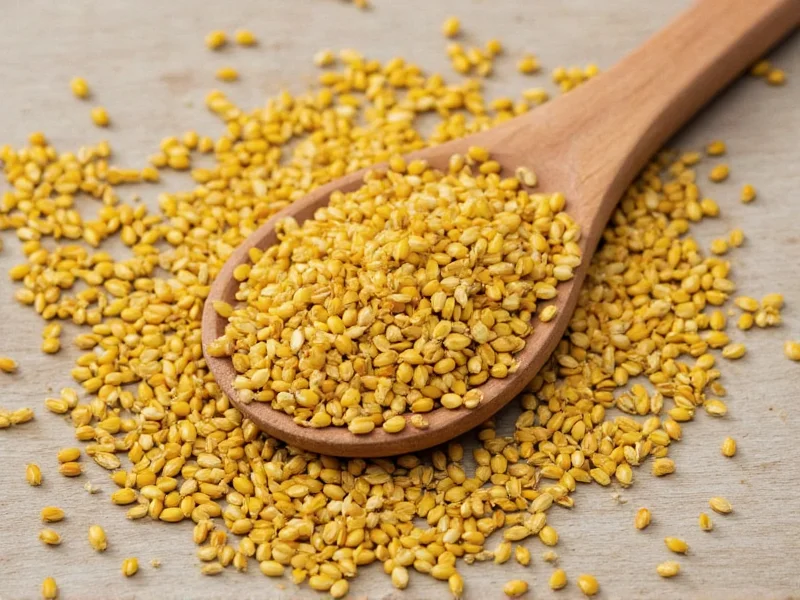The most effective replacements for mustard seeds include mustard powder (use 1 teaspoon powder for every tablespoon of seeds), prepared mustard (1 tablespoon equals 1 teaspoon of seeds, adjusting liquids accordingly), and horseradish (for pungency in cooked dishes). For Indian cuisine, cumin seeds provide similar texture while turmeric with vinegar mimics color and tang. The best substitute depends on your specific recipe and desired flavor profile.
When your recipe calls for mustard seeds and you find your pantry empty, knowing reliable alternatives can save your cooking project. Mustard seeds—whether yellow, brown, or black—add distinctive pungency, texture, and nutty flavor to dishes across global cuisines, particularly in Indian, Southern, and pickling recipes. Understanding proper substitutions prevents recipe failure while maintaining culinary integrity.
Why Replace Mustard Seeds?
Cooks seek mustard seed alternatives for several practical reasons: unavailable ingredients, dietary restrictions, flavor customization, or simply running out mid-recipe. Unlike many spices, mustard seeds provide both flavor and textural elements when tempered in oil—a technique crucial in Indian cooking where seeds crackle and release essential oils. Effective substitutes must address both chemical properties (glucosinolates creating that signature heat) and physical characteristics.
Top Mustard Seed Replacements Explained
Mustard Powder: The Closest Chemical Match
Mustard powder contains the same sinigrin compounds that create mustard's characteristic heat when hydrated. Use a 1:3 ratio—1 teaspoon powder replaces 1 tablespoon seeds. For tempering techniques, mix powder with cold water first to activate enzymes, then add to hot oil. This prevents bitterness while delivering authentic flavor. Yellow mustard powder works best for American-style recipes, while stone-ground provides more texture for European dishes.
Prepared Mustard: The Convenient Liquid Alternative
When seeds appear in wet ingredients, substitute 1 tablespoon prepared mustard for every teaspoon of seeds. Reduce other liquids by 1-2 teaspoons to compensate. Dijon works well for French recipes, while whole grain mustard preserves texture in relishes. Note that vinegar content affects pH-sensitive recipes like pickles—use this substitute when precise acidity matters less.
Horseradish: For Pungent Heat in Cooked Dishes
Freshly grated horseradish (1 tablespoon per 2 teaspoons seeds) delivers comparable sinus-clearing heat through similar isothiocyanate compounds. Best used in cooked applications like stews or braises where raw bite mellowes. Avoid in tempering techniques as it lacks seeds' oil-soluble flavor compounds. Ideal for Scandinavian meat dishes or as a Bloody Mary alternative.
Cumin Seeds: Texture Match for Indian Cuisine
When texture matters more than precise flavor—like in tempering for dals—use equal parts cumin seeds. They provide similar popping action in hot oil with earthy notes that complement many Indian dishes. The substitution works best in lentil dishes or vegetable stir-fries where mustard's sharpness isn't central. For enhanced approximation, add a pinch of turmeric for color.
Turmeric and Vinegar: The Color and Tang Solution
For recipes where mustard's yellow hue and acidity matter more than pungency (like salad dressings), combine ½ teaspoon turmeric with 1 teaspoon vinegar per tablespoon of seeds. This mimics visual and pH properties without the heat. Particularly useful in egg salads or potato salads where appearance matters. Add a pinch of paprika for depth in absence of roasted seed notes.
| Substitute | Ratio (vs 1 Tbsp Seeds) | Best For | Limitations |
|---|---|---|---|
| Mustard Powder | 1 tsp powder | Dressings, marinades, dry rubs | Lacks textural element of whole seeds |
| Prepared Mustard | 1 Tbsp mustard | Wet ingredients, sauces | Alters liquid ratios, contains preservatives |
| Horseradish | 1 Tbsp fresh | Cooked dishes, Bloody Marys | Heat dissipates faster than mustard |
| Cumin Seeds | 1 Tbsp seeds | Indian tempering, dals | Different flavor profile, earthier notes |
| Turmeric + Vinegar | ½ tsp turmeric + 1 tsp vinegar | Color-dependent dishes, salads | No mustard flavor, just visual/acidity match |
Selecting the Right Substitute by Cuisine
Culinary tradition significantly impacts substitution success. In Indian cooking where mustard seeds undergo tadka (tempering in hot oil), cumin seeds provide the closest textural experience despite flavor differences. For Southern-style pickling recipes, horseradish maintains necessary heat levels while prepared mustard better preserves acidity balance. European vinaigrettes often tolerate mustard powder substitutions seamlessly, whereas Japanese dishes might better utilize wasabi paste for similar enzymatic heat.
Special Considerations for Dietary Restrictions
Those avoiding mustard due to allergies should note that horseradish and wasabi belong to different plant families (Brassicaceae vs. Brassicaceae for mustard, but different genera) and are generally safe alternatives. For low-sodium diets, skip prepared mustard which often contains salt, opting instead for mustard powder with sodium-free liquids. Vegan cooks should verify that prepared mustard alternatives don't contain honey or dairy derivatives.
Advanced Substitution Techniques
Professional chefs sometimes combine substitutes for layered results. Try mixing equal parts cumin and fennel seeds with a pinch of asafoetida for complex Indian dishes. When making mustard-based sauces from scratch, blend mustard powder with reconstituted chia seeds to mimic both flavor and texture of whole seeds. For fermented applications like sauerkraut, add horseradish root pieces alongside cabbage to develop similar enzymatic complexity during fermentation.











 浙公网安备
33010002000092号
浙公网安备
33010002000092号 浙B2-20120091-4
浙B2-20120091-4